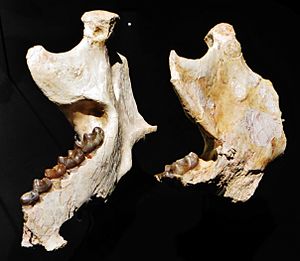Daouitherium
| Daouitherium | ||||||||||||
|---|---|---|---|---|---|---|---|---|---|---|---|---|

Lower jaw of Daouitherium rebouli |
||||||||||||
| Temporal occurrence | ||||||||||||
| Upper Paleocene to Lower Eocene ( Thanetian to lowest Ypresian ) | ||||||||||||
| 59.2 to 50.7 million years | ||||||||||||
| Locations | ||||||||||||
| Systematics | ||||||||||||
|
||||||||||||
| Scientific name | ||||||||||||
| Daouitherium | ||||||||||||
| Gheerbrant , Sudre , Cappetta , Iarochène , Amaghzaz & Bouya , 2002 | ||||||||||||
| Art | ||||||||||||
|
||||||||||||
Daouitherium is a genus of early proboscis . It livedin North Africa in the transition from the Paleocene to the Eocene from 59 to 51 million years ago. The fossils discovered so far belong to a not fully grown individual; due to the size of the finds, a body weight of 80 to 170 kg is assumed.
features
Daouitherium is only known from a few mandibular fragments and isolated molars of a non-adult animal. The longest fragment is a left branch of the jaw, which is 12 cm long and 5 cm high on the bone body. The more heavily damaged right jaw branch also has the joint attachment. The anterior dentition is not fossilized, but proven by the four existing alveoli . These are each a small distance from one another, so that the front dentition was probably not closed. The foremost alveolus is quite large and indicates that Daouitherium also had an elongated first incisor (I1). The other chambers are difficult to assign because juvenile animals sometimes have a different set of teeth than adult animals, but the researchers assume that these chambers are to be assigned to the other two incisors and the canine .
The posterior dentition includes the last three premolars and the three molars , the first premolar was probably already reduced, as in other early proboscis such as Phosphatherium and Numidotherium . The premolars are slightly molarized with an enamel ridge on the chewing surface, the last one bearing the attachment of a second ridge ( semibilophodont ). The molars are clearly bilophodontic, their size increases sharply towards the rear. The last molar has the beginnings of a third groin. Overall, the molars are low-crowned ( brachyodont ).
Systematics
|
Abbreviated internal systematics of the early proboscis according to Tabuce et al. 2019
|
Daouitherium is a genus of the order of Rüsseltiere (Proboscidea). Due to the bilophodontic anterior molars, it belongs to the original Plesielephantiformes and is one of the oldest known representatives of the proboscis along with Eritherium and Phosphatherium . Another indication of the very original position is the existing vertical change of teeth with simultaneous use of all teeth; the horizontal tooth change typical of today's elephants did not develop until later. Its clearly Lophodonten teeth place Daouitherium closer to Phosphatherium and Numidotherium , whereby it probably occupied a kind of intermediate position. An archaic feature compared to Numidotherium is the lack of diastema between the anterior and posterior teeth, compared to Phosphatherium , the significantly larger body shape is much more modern. A direct assignment to the family Numidotheriidae was only possible with a question mark. There are clear differences to the somewhat later forms Arcanotherium and Moeritherium , whose molars were shaped more like bunolophodont and so were closer to the later proboscis.
Discovery story
The finds were discovered in the northeastern area of the Ouled Abdoun Basin in the Sidi Daoui (Grand Daoui) section of Morocco . The phosphate mines there usually open up layers of the Thanetian (late Paleocene ) and lower Ypresian (early Eocene ) and are known for their rich fossils. With eritherium and phosphatherium also two very early mammoths were discovered here. The remains of Daouitherium were found by locals in Sidi Daoui. Roland Reboul, an amateur paleontologist, bought the finds from a fossil dealer. The holotype (copy number CPSGM MA4) shows a left lower arch with the preserved dentition of the last two premolars and all molars. Today it is kept in the paleontological collection of the Office Chérifien des Phosphates (OCP). The generic name Daouitherium refers on the one hand to the site in Sidi Daoui, on the other hand θηρίον ( thērion ) is the Greek word for "animal". The species name rebouli honors the finder Ronald Reboul, who made the finds available to the scientists.
Individual evidence
- ↑ a b c d Emmanuel Gheerbrant, Jean Sudre, Henri Cappetta, Mohamed Iarochène, Mbarek Amaghzaz and Baâdi Bouya: A new large mammal from the Ypresian of Morocco: Evidence of surprising diversity of early proboscideans. Acta Palaeontologica Polonica. 47 (3), 2002, pp. 493-506
- ↑ Rodolphe Tabuce, Raphaël Sarr, Sylvain Adnet, Renaud Lebrun, Fabrice Lihoreau, Jeremy E. Martin, Bernard Sambou, Mustapha Thiam and Lionel Hautier: Filling a gap in the proboscidean fossil record: a new genus from the Lutetian of Senegal. Journal of Paleontology, 2019, doi: 10.1017 / jpa.2019.98
- ^ Emmanuel Gheerbrant, Jean Sudre, Pascal Tassy, Mbarek Amaghzaz, Baâdy Bouya and Mohamed Iarochène: Nouvelles données sur Phosphatherium escuilliei (Mammalia, Proboscidea) de l'Éocène inférieur du Maroc, apports à la phylogénie lophodontoscidésie des Proboscides. Geodiversitas 27 (2), 2005, pp. 239-333
- ^ Cyrille Delmer: Reassessment of the generic attribution of Numidotherium savagei and the homologies of lower incisors in proboscideans. Acta Palaeontologica Polonica 54 (4), 2009, pp. 561-580